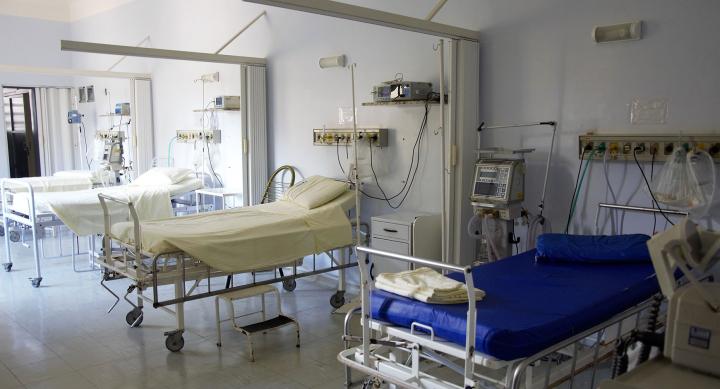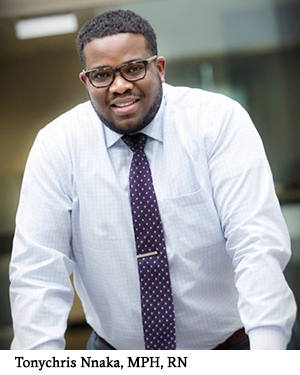
By Tonychris Nnaka
Tonychris Nnaka, MPH, RN is an Associate Manager of Critical Care Unit at Parkland Health and Hospital System in Dallas Texas and a nursing PhD student from the School of Nursing at the University of Texas at Austin.
In March of 2020, when we had limited knowledge on the infectivity and virulence of the virus that causes COVID-19, I joined a team of critical care nurses who were willing to risk their lives to care for those suffering from COVID-19. As a full-time PhD student in nursing, a new parent to my infant son, a primary caregiver to my 73-year-old mother, and as someone with a known history of severe asthma, I knew that I was embarking on a journey that could potentially cost me my professional and personal dreams and endanger those I care for the most in life: my family. My intentions to practice only part-time as a critical care nurse while pursuing full-time studies were halted after only two weeks of managing critically ill COVID-19 patients early in the pandemic. The countless code blues and unprecedented levels of patient deaths made it clear that we were in uncharted territory. After seeing the pain and fear on the faces of my nursing peers, I knew I could never leave them behind in this new battlefield. So, I stayed at bedside full-time for a year while also maintaining my full-time status as a PhD student. I had to. I could not turn my back on my practice oath, or my future professional goals as a nurse scientist. It is in this spirit that, on behalf of myself and my exhausted colleagues, I call on those with critical care experience who have stepped away from bedside to return, as they are able, and answer this same call to action.

The extent of the critical care nursing shortage we are currently experiencing is alarming to me and almost beyond my comprehension. This shortage has forced critical care nurses who have been at bedside since March of last year to remain at bedside even as several of us have reached the breaking point of psychological exhaustion. Our desperate outcry for backup from our fellow critical care nurse colleagues seems to have yielded no outcome. It is obvious that addressing this shortage would require a solution with immediate implementation as we do not have time for the training of more critical care nurses. Thus, an immediate call to all nurse anesthesia students to return to bedside should be a part of any strategy geared towards quickly addressing issues of this critical care nursing shortage.
At a time when the role of critical care registered nurses is most needed, several nurse anesthesia programs continue with their regular admission cycle protocol: pulling critical care nurses away from bedside. At my current hospital, we lost nearly a dozen critical care nurse colleagues to nurse anesthesia programs between March and May of 2020 at the peak of the pandemic. Since the nurse anesthesia program requirements stipulate a minimum of one year of critical care nursing experience, all program applicants possess highly specialized clinical skills needed for the care of critically ill COVID-19 patients. While there are unarguable reasons as to why some nurse anesthesia students have yet to answer this urgent call to duty, we as a profession, and as a society must do what we can to incentivize them to return to bedside to help relieve the suffering of patients and exhausted nurses who have fought tirelessly at the frontlines since the onset of the pandemic – many of whom have lost their lives as a result.
As leaders with the ability to persuade their members and lawmakers, professional nursing organizations such as the American Association of Nurse Anesthetists (AANA) and American Nurses Association (ANA) should be at the forefront of encouraging nurse anesthesia students to return to bedside. For example, by facilitating partnerships between nurse anesthesia programs and nearby hospitals with high COVID-19 patient census and assisting these programs to develop academic credit incentives for students who choose to render critical care nursing assistance to hospitals. Importantly, professional nursing organizations have the ability to advocate at a national level with policymakers for other incentives that can support nurses returning to bedside. Such incentives could be loan forgiveness programs for nurse anesthesia students (and other graduate students with critical care experience) in an exchange for time at bedside. We should be persuading our nation’s policymakers and healthcare leaders to invest in these students rather than solely devoting national emergency funds to travel nursing agencies. AANA and ANA, among other professional nursing organizations, must also get creative in collaborating with policymakers, education programs, and employers to reduce the risk of a potential max exodus of burnt out nurses away from bedside at the end of the pandemic.
To reiterate, we the nurses who have been at bedside since the beginning of this pandemic are burned out and near exhaustion, right as the pandemic reaches record numbers of deaths and hospitalizations each day. While thanking us for our sacrifice, calling us heroes, and sending us food are nice gestures, we desperately need real action from policymakers, professional nursing organizations, and the public to bring us real relief that can empower us to sustain ourselves for the sake of providing the best patient care possible. We can start by empowering our nurse anesthesia students to return to bedside to relieve exhausted expert nurses with fresh expert nurses.
Acknowledgement
Article originally published on The Health Care Blog.

